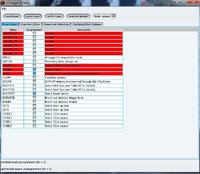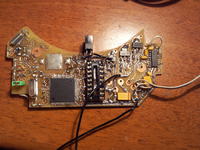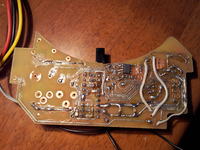Hello, I am French and I do not understand the Polish and very little mastery English! So, I'm doing the translation with Google. Thank you for your understanding.
I wish to realize "HHDClock" which is sensational: congratulations for this realization. I have two problems: the diodes "MARITEX" are not available, can I replace them with these LEDs found on Ebay or else at "TME"? Some resistance values are different between the scheme and PCB photos: eg R2-R13-R14 = 47 Ω and on PCB = 100, R1 = 100 Ω and on PCB 150, R3-R4-R5-R11 = 10 k & nbsp; and on PCB 4.7 k, R15-R16-R17 = 10 k & nbsp; and on PCB 47 k's!
Thank's for your answer. Best regards.
Hello, I am French and I do not understand Polish and very little mastery of English! So I do the translation with Google. Thank you for your understanding.
I want to realize "HHDClock" which is sensational: congratulations for this achievement. I have two concerns: the "MARITEX" diodes are not available, is it that I can replace them with these LEDs found on Ebay or another in "TME"? Some resistance values are different between the schematic and PCB pictures: eg R2-R13-R14 = 47 Ω and 100 & 93; = PCB, R1 = 100 Ω and 150 & 93; PCB, R3-R4-R5-R11 = 10 k & nt; and PCB 4.7 k, R15-R16-R17 = 10 k & 937; and 47 k Ω PCB!
Thank you for your response. Cordially.
Witam, jestem Francuzem i compend polską i bardzo mało mistrzostwo
Angielski! Więc robię tłumaczenia z Google. Dziękuję za zrozumienie.
Chcę zrozumieć "HHDClock", który jest rewelacyjny: gratulacje za to
realizacja. Mam dwa zastrzeżenia: diody "MARITEX" denies to dostępne,
Czy to, co mogę wymienić i na te LED znaleźć w domu ebay lub inne
"TME"? Niektóre wartości rezystancji różnią się między schematem i
PCB zdjęcia: np. R2-R13-R14 = 47 ] i 100 Ω = PCB, R1 = 100 Ω i PCB
150, R3-R4-R5-R11 = 10 k & nt; PCB 4.7 k, R15-R16-R17 = 10 K & sub4; i 47k & 937; PCB
Dziękujemy za answer.Kind.
CHARACTERISTICS:
Low energy consumption
IC Compatible
Intensely bright
TECHNICAL CHARACTERISTICS:
Emitting Color: 3-CHIPS PLCC-6 SMD SMT LED RGB CONTROL MANUAL
Lens type: clear water
Wavelenth: RED: 625-630 nm; BLUE: 465-470nm; GREEN: 520-525nm
Luminous intensity: RED: 6000mcd; BLUE: 5000mcd; GREEN: 6500mcd
Reverse voltage: 5.0 V
DC Voltage: RED: 1.8-2 0.4 V; BLUE: 3.0-3.6V; GREEN: 3.0-3.6V
DC Current: 20mA
Angle of vision: 120 degrees
Direct Temp solder: 260 ° C for 5 seconds
Intensely bright
Angle of vision: 120 degree PLCC-6 Power SMD LED size:
Absolute maximum ratings & agrave; Ta = 25 ° C
Articles Symbol Absolute maximum score Unit
Power Dissipation PD 100 mW
DC current SI 20 mA
Direct crimp * IFP current 30 mA
Reverse voltage VR 5 V
Operating temperature Topr -40 ~ 85 ℃
Storage temperature Tstg -10 ~ 100 ℃
Set the welding temperature Tsol Max.260 ° C for max. (3 mm from the base of the epoxy light bulb)
* Pulse width of 0.1 ms ≦ duty ≦ 1/10
Electrical / Optical Characteristics Ta = 25 ° C
Articles Symbol Condition Min. Typ. Max. Unit
Dissipation of the front VF SI = 20mA 3.00 / 3.60 V
Invert DC (DC) IR VR = 5V / / 10 uA
Dominant wavelength D D SI = 20mA / / /
Luminous intensity IV SI = 20mA / / / mcd
Power angle of 50% △ θ SI = 20mA / + plusmn; 60-70 / deg
http://www.ebay.com/itm/20-PCS-PLCC-6-5050-3-...=LH_DefaultDomain_0&hash=item56374973a6Ω








